How to take buckwheat with kefir in the morning if you have diabetes
Patients with diabetes are often recommended to have buckwheat porridge with kefir for breakfast. This advice is motivated by the fact that the dish lowers blood sugar. Some consider this to be fiction, while others consider it to be true. From our article you will learn where this recommendation came from and what you should really expect from such a combination.
Calorie content, BJU, nutritional value, glycemic index of buckwheat and kefir
Calorie content 100 g raw buckwheat is 308 kcal.
Macronutrient content in buckwheat (per 100 g of dry product):
- proteins –12.6 g;
- fats – 3.3 g;
- carbohydrates – 57.1 g.
Macronutrients are nutrients that a person needs daily and in large quantities to replenish energy costs. These include proteins, fats, carbohydrates.
Glycemic index raw buckwheat – 55.
Reference. The glycemic index is a relative indicator that reflects the change in blood glucose levels depending on the mass of carbohydrates entering the body with food.
The calorie content of 100 g of kefir with 1% fat content is 40 kcal.
Content of macronutrients in kefir (per 100 g of product):
- proteins – 3 g;
- fats – 1 g;
- carbohydrates – 4 g.
The glycemic index of kefir is 30.
Does the combination of buckwheat and kefir increase blood sugar or decrease it?
Reducing sugar levels from eating buckwheat and kefir is a common myth.
If we consider the processes occurring in the body after eating this dish, we can see clear prerequisites for an increase in blood sugar levels. After all, buckwheat contains a large amount of carbohydrates.
From six to eight tablespoons of ready-made porridge can increase the glycemic index by 2-3 mmol/l, and if you also drink a glass of kefir, your sugar will increase to a level of 3-4 mmol/l.
Also, with an increase in the consumed mass of the product, the glycemic index will increase. Therefore, you should not abuse it. It is better to eat this mixture in the first half of the day, since when taken for dinner, sugar will be higher in the morning.
If your blood sugar is high (more than 8-9 mmol/l on an empty stomach), it is better not to use a combination of kefir and buckwheat. For breakfast, you should choose an option that is lower in carbohydrates. For example, the same buckwheat or any other cereal as a side dish (no more than 25% of the entire portion) in combination with vegetable, meat or fish dishes.
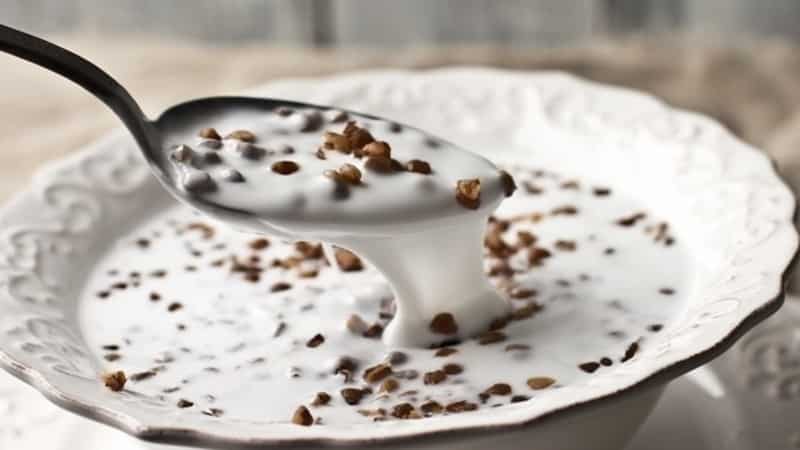
Vitamins and beneficial properties of buckwheat
Buckwheat contains a large number of micronutrients:
- Vitamins – A, groups B (B1, B2, B4, B5, B6, B9), E, N, K, RR.
- Minerals: calcium, potassium, silicon, magnesium, sodium, phosphorus and others.
Micronutrients are irreplaceable biologically essential nutritional components that are required in small quantities (mg or mcg) and do not act as sources of energy. This group includes vitamins and minerals (macro- and microelements).
Due to the high content of vitamins and minerals, buckwheat has a number of beneficial properties:
- reduces cholesterol levels, preventing the formation of plaques in blood vessels;
- accelerates metabolic processes in the body;
- improves hematopoietic processes;
- reduces the risk of blood clots;
- maintains the cardiovascular system in normal condition;
- helps get rid of chronic fatigue;
- cleanses the body of toxins.
Is it possible to consume kefir with buckwheat in the morning if you have type 1 or type 2 diabetes?
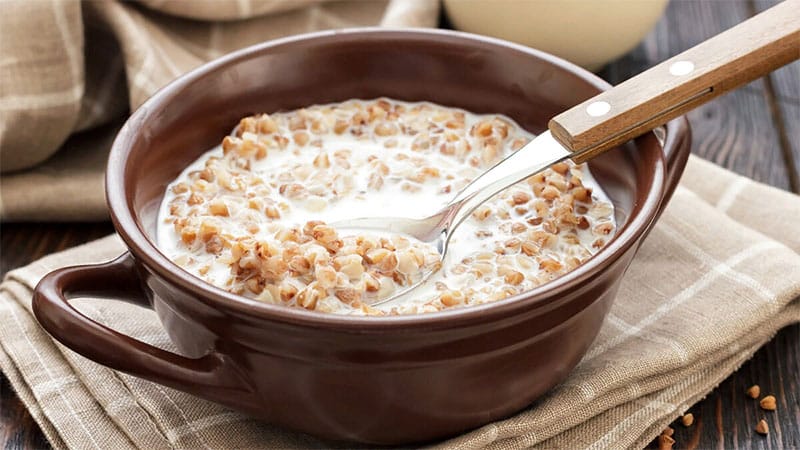
Buckwheat recommended for use regardless depending on the type of diabetes (with type 1 - less), since it has a normal glycemic index, unlike other cereals. It is recommended to eat 6-8 tablespoons of ready-made porridge at one time.
Cereals are especially beneficial when consumed with kefir - this method makes their absorption easier. This product improves digestion due to the presence of lactic acid bacteria, is useful for building bone tissue and does not affect surges in sugar levels.
However, you shouldn’t get carried away and eat a lot of cereals. It is necessary to evaluate in advance the benefits and harms of the amount of food consumed.
Important! Eating buckwheat with kefir as part of a diet should only be done after consultation with a doctor and under his supervision.
How can she harm
You should not resort to eating buckwheat with kefir for breakfast if:
- the presence of allergic reactions to one of the components;
- problems with the cardiovascular system;
- frequent or chronic hypotension;
- acute inflammatory processes in the gastrointestinal tract;
- previous anorexia or bulimia;
- renal failure;
- pregnancy and breastfeeding.
What is the benefit
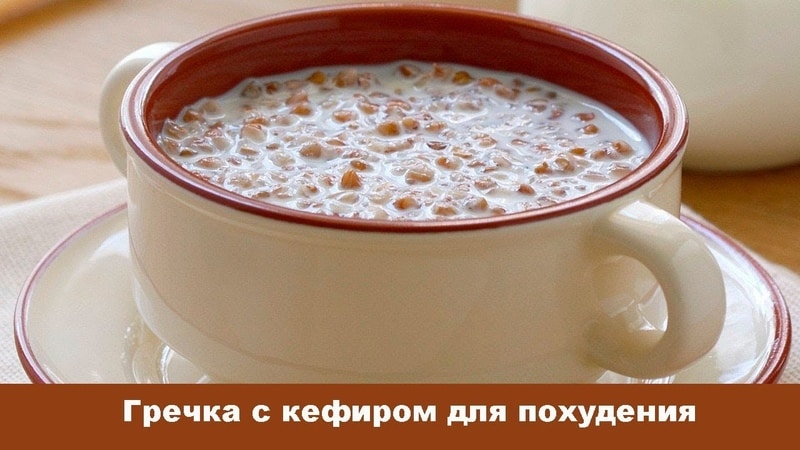
Benefits of eating this breakfast may include:
- weight loss due to high protein and low fat content;
- increased blood sugar levels, which will be used up in the morning;
- improved well-being due to cleansing the body of toxins;
- normalization of water-salt balance;
- cessation of putrefactive processes in the intestines thanks to fiber and lactic acid bacteria;
- strengthening the immune system;
- improvement of stomach function and normalization of intestinal microflora.
How to properly and how often consume buckwheat with kefir in the morning if you have type 1 or type 2 diabetes
It is recommended to use it on an empty stomach in the morning for two to three days. Then take a break for three days.
There can be no more than four such cycles in a row, after which it is recommended to take a break for three months.
How to choose buckwheat
Depending on the type of thermal and mechanical treatment, there are several types of buckwheat:
- The kernel is a whole grain, freed from the husk. Thanks to heat treatment, it acquires a shade from light brown to dark brown.
- Green buckwheat - the same buckwheat kernels, peeled and sifted. It got its name because it was not subjected to heat treatment. Green buckwheat is less digestible, but is considered healthier than other varieties. Sprouted grains contain many antioxidants.
- Prodel – finely crushed buckwheat kernels. Porridge made from this type of cereal is less crumbly, a little more viscous, but feels softer and more tender.
- Smolensk groats are produced by highly grinding the grains. It is intended for children and the elderly.
You should choose from the varieties of cereals based on your needs.
For example, Smolensk groats are ideal for an elderly person, kernels and green buckwheat are ideal for lovers of crumbly porridges, and buckwheat is the choice for those who cook viscous porridges.
How to soak buckwheat with kefir for diabetes
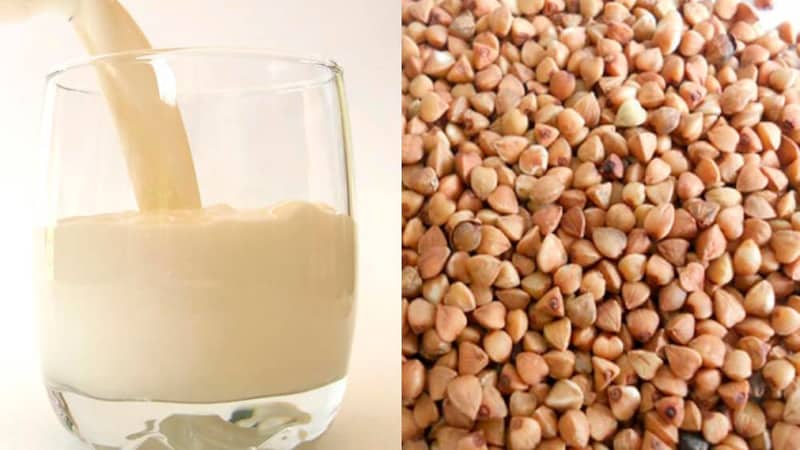
Let's look at several varieties of combining buckwheat with kefir.
Buckwheat soaked in kefir
Ingredients:
- core – 60 g;
- kefir – 250 ml.
Shake the kefir well and pour it over the washed buckwheat. Close the container and leave in the refrigerator for at least 8 hours. By morning, the cereal will swell and become soft.
Boiled buckwheat mixed with kefir
Ingredients:
- core – 100 g;
- water – 200 ml;
- kefir – 200 ml.
Rinse the cereal and cover with cold water and cook over low heat until it boils. Then leave the pan covered for half an hour with the heat off to steam. Mix the infused porridge with kefir and eat.
Steamed green buckwheat with kefir
Ingredients:
- green buckwheat – 60 g;
- boiling water – 250 ml;
- kefir 1% fat – 250 ml.
Rinse the green cereal, pour boiling water over it and wrap for 30-40 minutes. Mix the prepared warm porridge with kefir.
Consumption rate
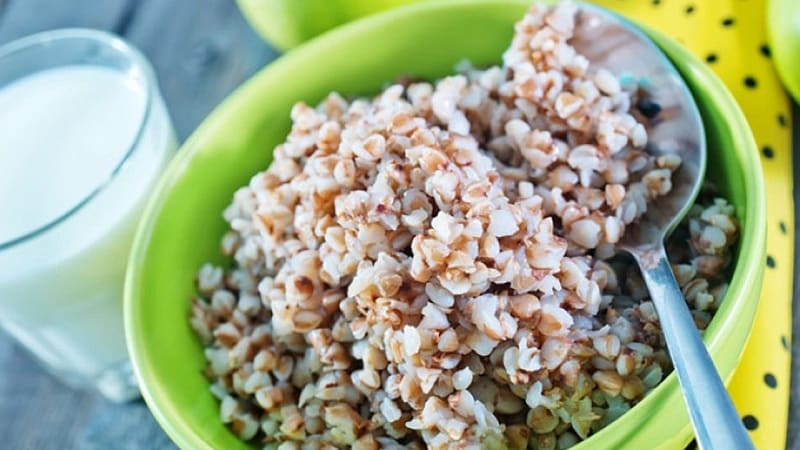
A single serving of a ready-made breakfast dish for an adult is 150-200 g, depending on the degree of saturation.
Conclusion
Alas, in nature there is no universal product that reduces or lowers blood sugar levels. It is more effective to combine glucose-lowering medications, proper nutrition and a healthy lifestyle. Therefore, a dish of buckwheat and kefir for breakfast can be used as part of a balanced diet, saturating the body with vitamins, nutrients and minerals. However, there are contraindications, and you should consult your doctor before use.